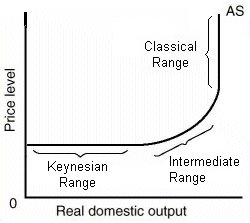February 22, 2016
Input Prices
Domestic resource prices
-wages (75% of all business costs)
-capitol cost
-raw materials (commodity prices)
Foreign resources prices
-strong $ = low foreign resource price
-weak $ = higher foreign resource prices
Market power
-increase in resource prices = SRAS ß
-decrease in resource prices = SRAS à
Productivity
Total output/total inputs = productivity
·
More productivity = lower unit production cost =
SRAS
·
Lower productivity = higher unit production cost
= SRAS
Legal- institutional environment
·
taxes and subsidies
-taxes ($ to government) on
business increase per unit production cost = SRAS
-subsidies ( $ from government) to
business reduce per unit production cost = SRAS
Government regulation
-government regulation creates
cost compliance = SRAS
-deregulation reduces compliance
cost = SRAS
Full employment
·
Full employment occurs where AD intersects SRAS
and LRAS at the same point
Recessionary gap
·
Recessionary gap exists when equilibrium occurs
below full employment output
Inflationary gap
·
An inflationary gap exists when equilibrium occurs
beyond full employment output
Changes in AD
·
Change in consumption (c)
-c ^: AD : GDPr ^ & PL ^: U% v
-c v: AD
·
Change in gross private investment (Ig)
-Ig ^: AD
-Ig v: AD
·
Government spending (G)
- G ^ : AD
- G v : AD
·
Net exports (Xn)
-Xn ^ AD
-Xn v AD
Changes in SRAS
·
Input prices
- input prices v : SRAS
- input prices ^ : SRAS
·
Productivity
-productivity ^ : SRAS
-productivity v : SRAS
·
Legal-institutional environment
- deregulation : SRAS
- regulation : SRAS
Nominal wages- the
amount of money received by a worker per unit of time (how much you make)
Real wages- amount of goods and services that a
worker car purchase with their nominal wages (purchasing power of nominal
wages)
Sticky wages- nominal wage level that is set according to an
initial level and does not vary due to labor contracts or other restrictions.
Output- depends upon changes in the employment level.
Output depends upon changes in price and employment level output is independent
in changes in price level.
Keynasian
Range
Classical range
|
|
price
|
Wages
|
Employment level
|
implications
|
recession
|
fixed
|
fixed
|
flexible
|
|
Intermediate
|
flexible
|
fixed
|
flexible
|
|
inflation
|
flexible
|
flexible
|
fixed
|
|





